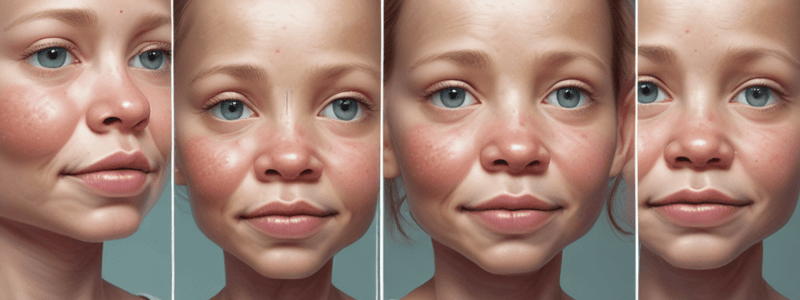Podcast
Questions and Answers
What percentage of all anomalies affecting the head and neck does cleft lip and palate comprise of?
What percentage of all anomalies affecting the head and neck does cleft lip and palate comprise of?
- 40%
- 70%
- 65% (correct)
- 50%
What is the prevalence of cleft lip and palate among Caucasians?
What is the prevalence of cleft lip and palate among Caucasians?
- 1 in every 1500 live births
- 1 in every 1000 live births
- 1 in every 700 live births (correct)
- 1 in every 500 live births
At what week of intra-uterine life does the fusion of the maxillary and medial nasal processes occur?
At what week of intra-uterine life does the fusion of the maxillary and medial nasal processes occur?
- 10th week
- 8th week
- 4th week
- 6th week (correct)
What percentage of cases of cleft lip have a family history?
What percentage of cases of cleft lip have a family history?
What is the term for the process by which the palatal shelves change from a vertical to a horizontal position?
What is the term for the process by which the palatal shelves change from a vertical to a horizontal position?
What is the term for the palate that forms after the fusion of the maxillary and medial nasal processes?
What is the term for the palate that forms after the fusion of the maxillary and medial nasal processes?
What is the proportion of cases of cleft lip with or without cleft palate that have a family history?
What is the proportion of cases of cleft lip with or without cleft palate that have a family history?
What are the three main features affected by cleft lip and/or palate?
What are the three main features affected by cleft lip and/or palate?
What percentage of CLP patients require orthognathic surgery?
What percentage of CLP patients require orthognathic surgery?
At what stage should prosthetic replacement be carried out?
At what stage should prosthetic replacement be carried out?
What is the primary focus of management in CLP?
What is the primary focus of management in CLP?
What is the current state of management of CLP in Egypt?
What is the current state of management of CLP in Egypt?
What is the importance of standardised records in CLP management?
What is the importance of standardised records in CLP management?
What is the typical duration of CLP management?
What is the typical duration of CLP management?
What is the primary benefit of concentration of expertise and experience in CLP management?
What is the primary benefit of concentration of expertise and experience in CLP management?
What is the most common craniofacial malformation affecting the head and neck?
What is the most common craniofacial malformation affecting the head and neck?
What is the primary responsibility of the specialized nurse in the management of cleft babies?
What is the primary responsibility of the specialized nurse in the management of cleft babies?
At what age is surgical repair of cleft lip usually carried out?
At what age is surgical repair of cleft lip usually carried out?
What is the purpose of nasal stents in the management of cleft babies?
What is the purpose of nasal stents in the management of cleft babies?
What is the average age for pharyngeal surgery in the management of cleft babies?
What is the average age for pharyngeal surgery in the management of cleft babies?
What is the primary goal of presurgical orthopaedic alignment in the management of cleft babies?
What is the primary goal of presurgical orthopaedic alignment in the management of cleft babies?
At what age does speech assessment typically start in the management of cleft babies?
At what age does speech assessment typically start in the management of cleft babies?
What is the term used to describe the process of adding nasal stents to improve alar support?
What is the term used to describe the process of adding nasal stents to improve alar support?
Why is the closure of the hard palate sometimes delayed until 5 years of age in some European centres?
Why is the closure of the hard palate sometimes delayed until 5 years of age in some European centres?
What is a potential problem associated with velopharyngeal insufficiency?
What is a potential problem associated with velopharyngeal insufficiency?
What is a common dental anomaly associated with cleft lip and palate?
What is a common dental anomaly associated with cleft lip and palate?
What is the effect of surgical repair of a cleft lip and palate on facial growth?
What is the effect of surgical repair of a cleft lip and palate on facial growth?
What is the prevalence of other congenital abnormalities in individuals with cleft lip and palate?
What is the prevalence of other congenital abnormalities in individuals with cleft lip and palate?
What is the effect of velopharyngeal insufficiency on the Eustachian tube?
What is the effect of velopharyngeal insufficiency on the Eustachian tube?
What is a characteristic of the dental arch in unilateral cleft lip and palate?
What is a characteristic of the dental arch in unilateral cleft lip and palate?
What is the effect of cleft lip only on speech development?
What is the effect of cleft lip only on speech development?
What is a potential problem associated with feeding difficulties in individuals with cleft lip and palate?
What is a potential problem associated with feeding difficulties in individuals with cleft lip and palate?
What is the primary purpose of alveolar or secondary bone grafting in the mixed dentition stage?
What is the primary purpose of alveolar or secondary bone grafting in the mixed dentition stage?
At what age is the bone grafting procedure usually carried out?
At what age is the bone grafting procedure usually carried out?
What is the purpose of orthodontic treatment prior to graft placement?
What is the purpose of orthodontic treatment prior to graft placement?
What type of appliance is often used to expand the maxillary arch prior to graft placement?
What type of appliance is often used to expand the maxillary arch prior to graft placement?
What is the primary focus of orthodontic treatment during the permanent dentition stage?
What is the primary focus of orthodontic treatment during the permanent dentition stage?
What is the purpose of using a facemask with maxillary expansion plate?
What is the purpose of using a facemask with maxillary expansion plate?
Why is care taken not to move any teeth into the cleft site during orthodontic treatment?
Why is care taken not to move any teeth into the cleft site during orthodontic treatment?
What is the result of the restraining effect of surgery upon growth during the mixed dentition stage?
What is the result of the restraining effect of surgery upon growth during the mixed dentition stage?
Flashcards are hidden until you start studying
Study Notes
Cleft Lip and Palate (CLP)
- Cleft lip and palate is the most common craniofacial malformation, accounting for 65% of all anomalies affecting the head and neck.
- The prevalence of CLP varies geographically and between different racial groups, occurring in approximately 1 in every 700 live births among Caucasians (0.42/1000 live births).
Developmental Process
- In normal development, fusion of the maxillary and medial nasal processes occurs around the sixth week of intra-uterine life.
- The palatal shelves 'flip-up' from a vertical to a horizontal position, followed by fusion to form the secondary palate, around the eighth week.
- The embryological processes must grow until they come into contact before fusion can take place.
Feeding and Nutrition
- Feeding difficulties are associated with fatigue, poor weight gain, excessive air intake, and nasal regurgitation.
- Feeding problems depend on the type and severity of the cleft and whether both lip and palate are involved.
Speech and Hearing
- Velopharyngeal insufficiency affects speech development, as the soft palate is unable to make adequate contact with the back of the pharynx to close off the nasal airway.
- A cleft involving the posterior part of the hard and soft palate can cause hearing difficulties, which can also retard speech development.
- Cleft lip only is usually associated with minimal problems.
Dental and Orthodontic Issues
- Unilateral cleft lip and palate is associated with segmentation of the dental arch into lesser and greater segments.
- Bilateral clefts involve both lateral segments, often collapsed behind a prominent premaxilla.
- Delayed eruption, hypodontia, microdontia, and enamel defects are common dental anomalies.
- Individuals with unoperated clefts do not experience a significant restriction of facial growth.
Management and Treatment
- Management is a long-term, complex, multidisciplinary process that starts from birth and extends to over 20 years of age.
- The clinical nurse provides initial support and advice, and educates the mother on feeding the cleft baby.
- Presurgical orthopaedic alignment of the cleft alveolar segments may be carried out in the neonate.
- Surgical repair of cleft lip is usually carried out between 3 and 6 months of age, and cleft palate repair between 6-9 months or 9-12 months of age.
- Speech assessment starts by the age of 2 years, and pharyngeal surgery may be needed to improve velo-pharyngeal insufficiency.
- Alveolar or secondary bone grafting is performed around 8-10 years of age, before the eruption of the permanent canine.
- A period of orthodontic treatment is required prior to graft placement, followed by a period of retention.
- Orthognathic surgery may be required in 25% of CLP patients, and prosthetic replacement may be needed to replace missing teeth.
Importance of Multidisciplinary Care
- The most important thing in management of CLP is being able to audit the treatment progress among the different disciplines involved in care provision.
- Concentration of expertise and experience at certain centres of excellence produces superior results to those obtained by discrete practitioners.
- Standardised treatment protocols for management of CLP have been set in many countries, and careful standardised records should be taken before and after any intervention.
- Patients' registration systems are still lacking in most centres, and initiatives for establishment of a standardised national protocol have been taken to achieve a more efficient care of cleft patients.
Studying That Suits You
Use AI to generate personalized quizzes and flashcards to suit your learning preferences.



